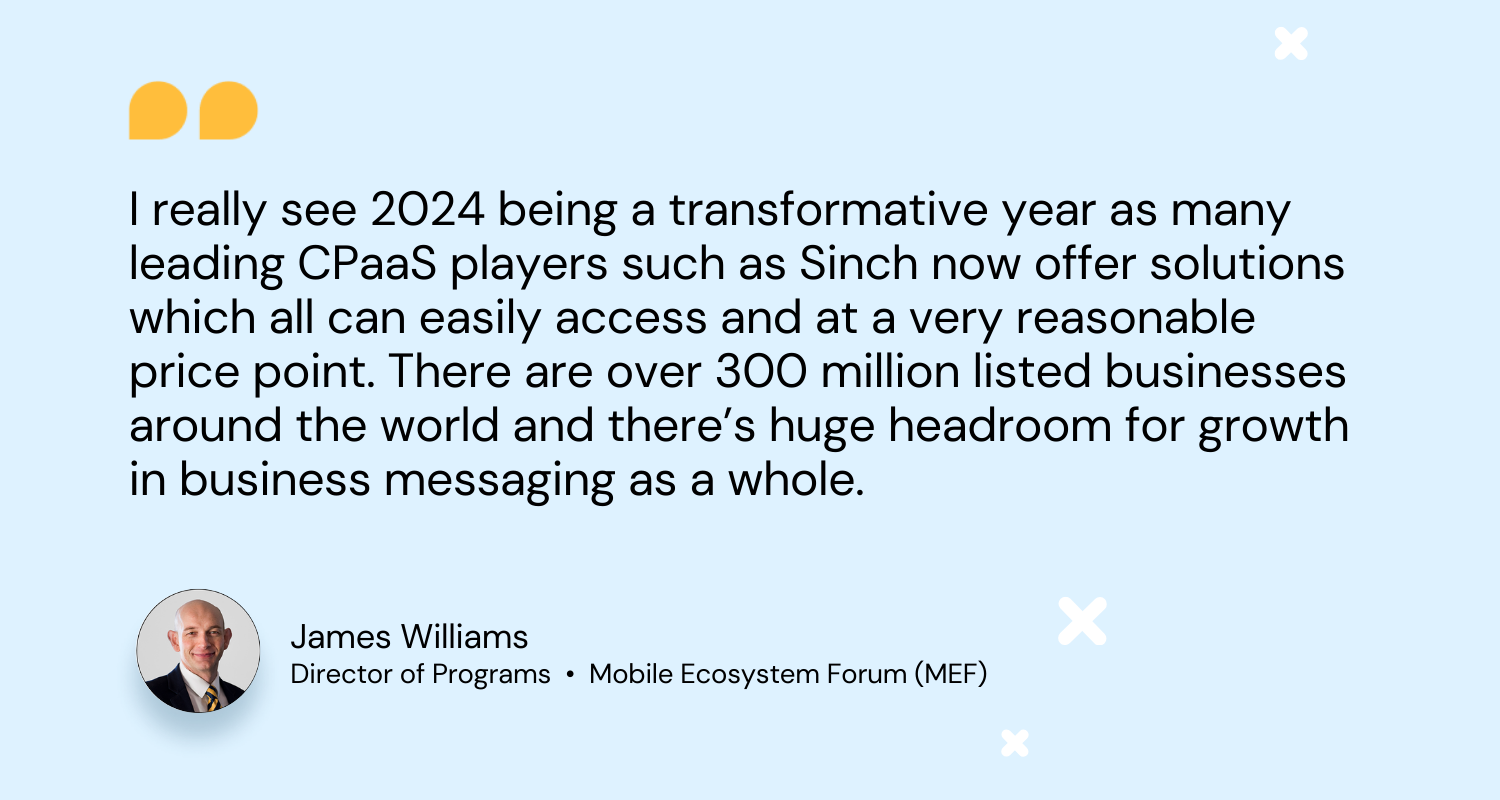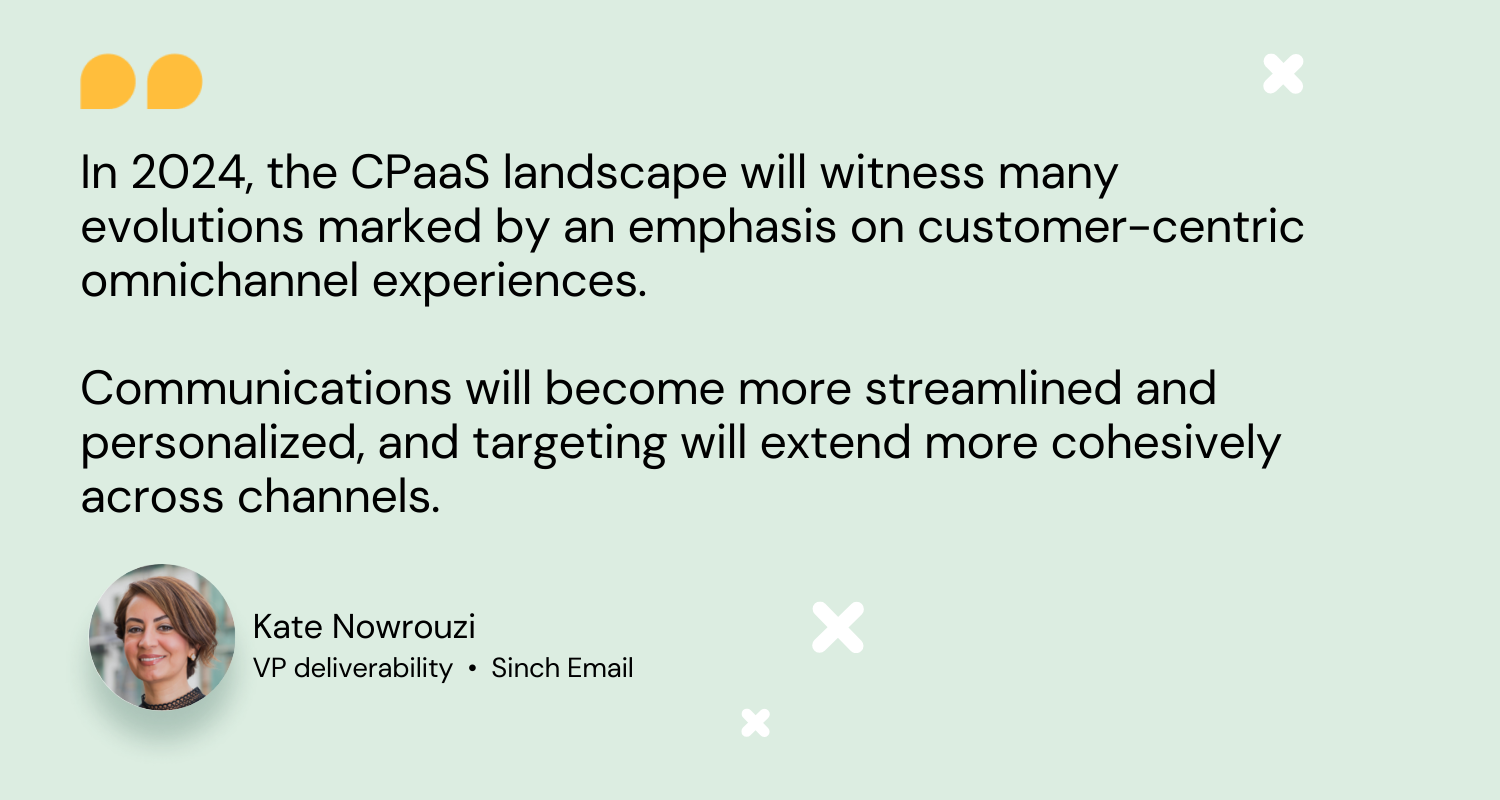Insights
5 trends set to define 2024 customer communications

Insights

Every year, there’s a number of tech trends that emerge as clear game-changers and become impossible to ignore.
Between the massive rise of generative AI, Apple’s adoption of RCS, and the exponential growth of conversational use cases, just to name a few, 2023 has been a wild and crazy ride in the customer communications space — and 2024 is shaping up to be just as disruptive.
To help you figure out where to focus in 2024, we asked 10 industry experts to take out their crystal ball and tell us what lies ahead. Keep reading to find out which customer communication trends you should keep an eye on and be prepared for this year.
Conversational channels will show no sign of slowing down in 2024. Why would they? Consumers are still clamoring for real-time, valuable interactions with businesses, and conversational channels are where meaningful engagement happens. And while this isn’t new, we expect to see exponential growth in conversational use cases this year.
Rick Van Esch, MD Sinch Engage, predicts that the growth of the Messageverse — which refers to conversational messaging channels like SMS, MMS, WhatsApp, RCS, WeChat, Line, KakaoTalk, Facebook Messenger, Apple Messages for Businesses, Telegram, or Signal — will still be outpacing that of the Metaverse in terms of time spent by end users.
Take WhatsApp, for instance. The channel saw a massive boom in usage in 2023, with 140 billion messages exchanged on the platform daily — that’s like 1.6 million messages every second!
India was leading the charge with a whopping 535.8 million users, followed by Brazil (148 million), Indonesia (112 million), and the U.S. (98 million).
Businesses worldwide (over 50 million of them) also jumped on the WhatsApp Business bandwagon to level up customer service, boost sales, and more — and this trend isn’t slowing down anytime soon.
Recent regulatory measures adopted in the U.S. to tackle unwanted robocalls and robotexts should further accelerate the growth of conversational use cases:
“Thanks to the recent FCC ruling on lead generators, there will be a renewed focus on opt-in consent hygiene. As a side effect, getting the consumer to initiate a text message will become a priority,” explained TJ Thinakaran, CEO of CasselRoad Consulting.
In 2024, we expect more and more of these conversations to take place on rich messaging channels, but also via voice calls, with significant progress expected in branded calling.
“For the voice call, there will be clarity on how brands can control their branding as it appears on the consumer’s device. This will then also mean branded calling for messaging will gain traction, especially across short code, 10DLC, toll-free, and now RCS,” said TJ Thinakaran.
Look around. Everyone’s talking, posting, and speculating about it. And the craze over all things RCS (Rich Communication Services) has only just started.
RCS adoption already made great strides in 2023, and with Apple bringing RCS support to iPhones this year, experts expect to see dizzying RCS growth in the near future.
In November 2023, brands sent 25,000 times more RCS messages than they did in February 2022 when RCS was still gaining momentum. Twenty-five thousand — let that number sink in for a minute.
And again, this is just the beginning. While many details are still unknown regarding the introduction of RCS on iOS devices, 2024 might be a transformative year for messaging strategies in markets — like the U.S. — where rich messaging adoption is still in early stages.
Matt Ramerman, Head of Enterprise Innovation at Sinch, predicts that RCS adoption, driven by the channel’s rich media, video, and conversational features, but also the granular event data available for campaign optimization, will have the biggest impact to CX strategies and direct-to-consumer communications since the invention of email.
What’s the best way to start out strong with RCS in 2024? Check out our blog post to learn everything you need to know about RCS messaging.

Oh, you thought A2P (Application to Person) SMS would die out in the wake of newer, flashier messaging channels? Think again. Despite the rise of rich business messaging (RBM), good old SMS is still going strong. In fact, it hasn’t even hit its peak yet and will continue to play an essential role well into 2024, and beyond.
James Williams, Director of Programs, Mobile Ecosystem Forum (MEF), sees SMS as the bedrock of business messaging, with use cases and growth opportunities spanning far beyond two-factor authentication:
“For years, I have been talking about the importance of the business messaging industry as a whole working together to ensure that fabulous innovations such as CPaaS, conversational commerce (and more) are truly accessible to organizations of all shapes, types and sizes. I really do see 2024 being a transformative year in this regard as many of the leading players such as Sinch now offer solutions which all can easily access and at a very reasonable price point. There are over 300 million listed businesses around the world and there’s huge headroom for growth in business messaging as a whole.”

As a global CPaaS leader, we have a pretty good idea of which customer engagement trends will go on to define 2024 — because we make interactions between businesses and consumers happen.
And if we know anything about this year, it’s this: Cross-channel engagement will be more crucial than ever. And we’re not just saying this. Recent data confirms it.
Let’s take 2023 Black Friday/Cyber Monday communications as an example:
The key takeaway? Combining channels strategically to harness their unique strengths and enable seamless cross-channel engagement is the way forward for brands looking to deepen customer relationships in 2024.
Companies will have to implement smarter, data-driven targeting across channels to meet customers where they want to be met rather than engaging their entire audiences or relying on a single communication pathway — and CPaaS will play a pivotal role in taking cross-channel strategies to the next level in agile, scalable ways.

Generative AI, including LLMs (Large Language Models), is one of the most talked about topics of 2023. From enhanced customer experiences to efficient automation, improved data insights, and more, the combination of generative AI and CPaaS technologies has the potential to unlock a whole new range of business opportunities, and companies in the space are already taking notice.
The Gen AI race in CPaaS has begun, with many providers now offering LLM-powered communication features. But the technology itself will no longer be a differentiator in 2024.
Kevin Nethercott, Managing Partner at CPaaS Acceleration Alliance, highlights the importance for providers to shift their focus from the technology itself to businesses’ needs and solutions as most platforms now offer similar capabilities.
When it comes to generative AI, this means software providers leveraging these technologies will need to deliver tangible value and support key use cases like customer service automation, customer data management, fraud and security, or personalization.
Anders Lenman, VP Voice Product & Operations at Sinch, expects to see generative AI become a central component of customer engagement strategies this year:
“This technology will vastly improve the possibility to automate personalization in customer engagement. With consolidated data across multiple engagement channels, the tools will be much better to customize messages and respond faster. This will lead to a significantly improved customer experience.”
Generative AI will likely enable access to CPaaS APIs for more businesses in 2024. Until today, there’s been a barrier for smaller companies to benefit from the cost advantage and reach of CPaaS. AI will allow these companies to create customized software to solve their unique challenges at a lower cost.
Of course, with new opportunities also come new challenges and risks. Fraudsters are always early adopters of new technology and we’re already seeing an increase in fraud attacks using AI tools.
Deepfakes in communication channels like video and voice calling, for instance, are expected to gain momentum, posing new challenges in terms of usage policy and regulation, and making it difficult for consumers to spot instances of fraud.
Tackling new AI-enabled fraud tactics will be a key concern in 2024, but AI will also be a part of the solution. It will enable CPaaS leaders to train models to protect their networks and end users more efficiently and react to threats faster.
This year will also be marked by stricter email sender protections.
Gmail and Yahoo have announced major changes impacting email inboxes effective early 2024. One change requires senders to adopt DMARC, an authentication that protects sender identities and can help to prevent bad actors from impersonating domains. DMARC has previously been encouraged but not required and can be set up with varying policies.
With current email authentication requirements, message filtering is left to the discretion of mailbox providers. By the end of 2024, a stricter policy will likely be implemented, which will mandate mail servers to reject messages that fail DMARC authentication.
“I’m optimistic that as more businesses utilizing email marketing adopt proper authentication methods, including DMARC, they will find transitioning to new policies easier than expected. This shift will be highly advantageous, especially as email providers strengthen security measures and enforce stricter standards,” said Kate Nowrouzi, VP Deliverability at Sinch.
Chad S. White, Head of Research at Oracle Digital Experience Agency, expects these new deliverability requirements to be polarizing:
“For large senders on dedicated IP addresses and sender domains, it will largely be a non-event. However, for smaller senders using shared IP addresses, the February deadline for compliance will likely bring nasty surprises. If some smaller email service providers struggle to comply with the authentication requirements, it may lead to a shakeup in the ESP landscape and vendor consolidation. If chaos does ensue, Google and Yahoo may rollback that portion of their mandate and provide more guidance.”
If guidance is what you need, check out our blog post where we dive into everything you need to know to prepare for new DMARC requirements.
This year will be decisive in many ways for the CPaaS industry. Insights from the 2023 State of CPaaS Report, which highlights key industry-defining trends, suggest that 2024 will see CPaaS take center stage both in telco and cloud communications. Let’s take a closer look.
Network as a Service (NaaS) is expected to gain more traction in 2024, with a focus on silent verification and fraud reduction.
With the Camara initiative, launched in collaboration with the GSMA and the main cloud industry bodies (Linux Foundation/CNCF), telco operators can enable easier access to their network capabilities for third parties through APIs, unlocking new revenue streams for both telcos and the CPaaS providers powering these network APIs.
Enterprises see a real value in silent verification and other network APIs provided by operators to tackle fraud and improve CX.
“This year will probably see mobile network operators make their big comeback in the CPaaS customer journey. Thanks to data and network APIs, the mobile phone number is still a way for operators to enable enterprises to combat fraud and protect the end user. The NaaS initiative will be a way to build more trust throughout the customer journey,” said Virginie Debris, Managing Director, Messaging at Sinch.
The lines between CPaaS, CCaaS, UCaaS, and SaaS will continue to blur in 2024, fueling market consolidation.
One of the driving forces behind this convergence is the growing demand for integrated, efficient, and versatile solutions that can support complex communication and operational needs.
Businesses are looking for tools that simplify collaboration and enable meaningful customer interactions and seamless service delivery. And what could be easier than using a single provider?
The consolidation of cloud solutions also brings about significant cost savings and efficiencies for businesses through integrated data analytics and reporting.
Integrated cloud communications offerings also simplify compliance and security management, and meeting the highest standards in these areas will continue to be a key concern for businesses across all industries in 2024.
This year is shaping up to be a year of meaningful innovation and opportunities at every turn, with advanced technology integration, accelerated channel adoption, and an increased focus on security in customer engagement — and a common red thread: CPaaS.